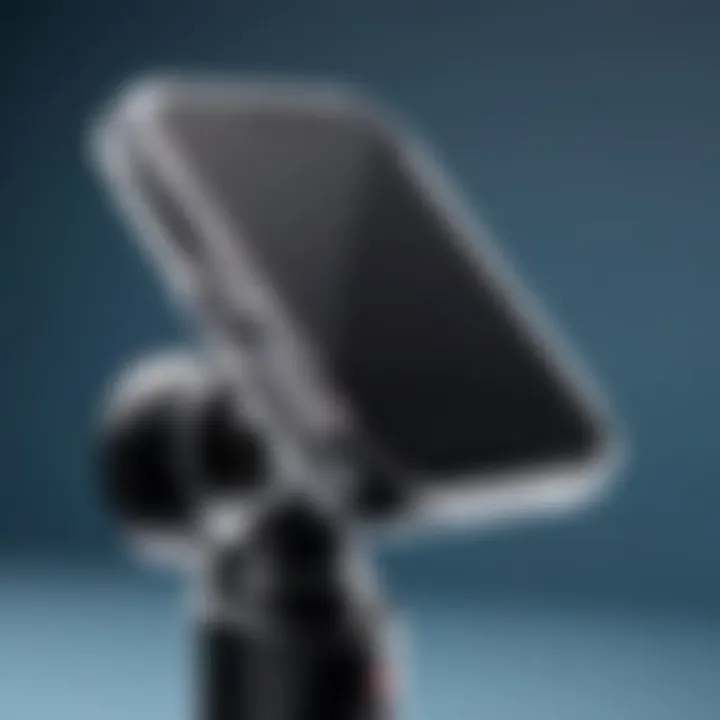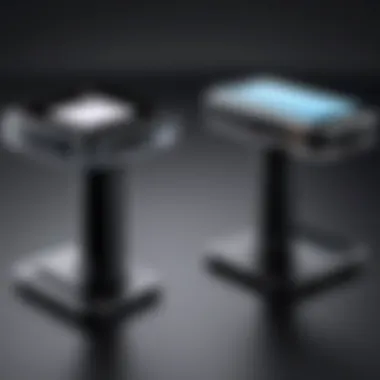Analyzing Handheld Phone Stabilizers for Videography


Intro
In the world of modern videography, capturing smooth, high-quality video has transitioned from a niche requirement to a fundamental expectation. Among the tools that have gained prominence in this evolution are handheld phone stabilizers. These nifty gadgets don’t just keep your footage steady during a walk or run; they empower both amateur hobbyists and seasoned professionals to create visually engaging narratives with their mobile devices. As technology has progressed, so too have the capabilities and functionalities of these stabilizers.
This comprehensive examination highlights the essential features of handheld phone stabilizers, diving into their specifications, unique selling points, and their ability to adapt to various shooting scenarios. Understanding these aspects is crucial for tech enthusiasts and IT professionals seeking to harness cutting-edge tools in multimedia production. Moreover, we’ll explore performance analysis and market trends, aiming to equip you with the knowledge needed to select the ideal stabilizer that meets your filming aspirations.
Features Overview
Handheld phone stabilizers are built with various features that significantly enhance the filming experience. Understanding these features is the first step in appreciating how they contribute to producing high-quality footage.
Key Specifications
Handheld stabilizers boast an array of specifications that directly influence their performance. Here are some critical points to consider:
- Weight Capacity: Most stabilizers can accommodate a broad range of phone models, but keep an eye out for weight limits to ensure compatibility.
- Battery Life: This influences how long you can shoot before needing a recharge. A longer battery life is especially beneficial during extended shooting sessions.
- Material Quality: Look for stabilizers made from durable materials like aluminum or high-grade plastics for enhanced longevity.
- Axis Stabilization: Different stabilizers offer varying numbers of axes for stabilization, typically ranging from two to three. More axes usually allow for better compensation of common movements.
Unique Selling Points
What distinguishes certain handheld stabilizers in a crowded market is their unique selling points. Here’s what you might find appealing:
- Smartphone Integration: Certain models sync seamlessly with apps, allowing for advanced features like tracking shots or time-lapses.
- Portability: Some stabilizers can fold up or be easily disassembled, making them travel-friendly for on-the-go filmmakers.
- Versatile Mounting Options: This includes options for attaching different accessories such as microphones and lights, expanding filming possibilities.
Performance Analysis
Evaluating the performance of handheld phone stabilizers is essential for anyone looking to enhance their video production quality.
Benchmarking Results
Through various tests, the performance of stabilizers is assessed against typical filming conditions. Factors considered include:
- Smoothness of Footage: Can the stabilizer effectively dampen jarring movements?
- Response Time: How quickly does the stabilizer react to changes in orientation?
- Ease of Control: Is it intuitive to operate?
These benchmarks help demonstrate the reliability of different models in real-world applications.
Real-world Scenarios
Stabilizers prove their worth in diverse scenarios:
- Travel Vlogs: Ensuring smooth footage while navigating bustling streets or scenic landscapes.
- Event Coverage: Capturing dynamic movements at weddings or concerts without jerky visuals.
- Documentaries: Allowing for unobtrusive shooting, particularly in sensitive environments.
In each of these scenarios, the characteristics of the stabilizer enhance the visual storytelling, making footage visually coherent while maintaining a natural look.
"Understanding the strengths of your equipment is half the battle won in the quest for cinematic brilliance."
By grasping these essential features of handheld phone stabilizers, tech-savvy individuals are better equipped to select the tool that perfectly aligns with their creative vision.
Understanding Handheld Phone Stabilizers
When it comes to capturing life's fleeting moments, handheld phone stabilizers have increasingly become essential tools for both amateur filmmakers and seasoned videographers. In this section, we’ll dive into the fundamental principles of stabilization technology and its significance in the world of videography.
The Basics of Stabilization Technology
Stabilization technology operates on a simple yet effective premise: to minimize unwanted motion during video capture. Traditional handheld filming can often lead to shaky footage, resembling a rollercoaster ride gone too far. Handheld phone stabilizers come into play by counteracting these unwanted movements through various mechanisms.
At their core, stabilizers usually employ a gimbal mechanism. This comprises motors and sensors that detect motion in real-time. When a filmmaker shifts the phone, sensors can instantly respond to this shift, stabilizing the image on the fly. You can think of it as having a personal assistant with eagle eyes, ensuring that every frame holds steady.
However, it’s not just a one-size-fits-all solution. There are several types and designs out there, each with its unique advantages and drawbacks. Understanding these basics can help you make sense of the multitude of options available on the market today. The technology continually evolves as well, blending with innovations like smartphone algorithms that aid in digital stabilization. This combination of mechanical and digital stabilization leads to cleaner footage, enhancing the overall viewing experience.
Importance in Videography
In the realm of videography, achieving smooth and steady shots is paramount. Shaky footage can be exactly what your audience doesn't want to see— it can divert attention from the content itself. Handheld phone stabilizers play a critical role in providing that smoothness, enabling professionals and hobbyists to produce high-quality videos consistently.
Here are some of the key benefits that underline the importance of these stabilizers:
- Improved Image Quality: Stabilizers help in achieving professional-looking results that can turn casual clips into captivating stories.
- Versatility in Filming Styles: Whether you're moving through a bustling street or filming a serene landscape, stabilizers allow for dynamic movement while maintaining steadiness.
- Enhanced Viewer Engagement: High-quality footage engages viewers better. When viewers are not distracted by shaky images, they can immerse themselves in the story being told.
"The right stabilizer can make or break a scene, affecting not just the footage, but how a narrative unfolds on screen."
Moreover, for social media content creators, the pressure to produce visually appealing material is constantly on the rise. A good stabilizer can set one apart, showcasing not just technical skills but a solid understanding of how to capture attention in an oversaturated market. The overall impact goes beyond just the aesthetic; it can actually influence engagement rates and audience retention.
Stabilizers are not merely a gadget; they are a bridge to storytelling excellence. In the following sections, we'll delve deeper into the design and functionality of various handheld phone stabilizers, providing a comprehensive understanding of these invaluable tools.
Design and Functionality
Design and functionality stand at the core of what separates a high-quality handheld phone stabilizer from a more generic option. For those seriously invested in videography, understanding these elements is not just beneficial; it's crucial. The design of a stabilizer determines its usability and comfort during extended shoots, while functionality encompasses how effectively it stabilizes footage in various conditions. As we dive into these components, you'll gain insights that will help you navigate the extensive market of stabilizers, making informed decisions based on your specific needs.
Structure and Components
The structure of a handheld phone stabilizer is often what first grabs attention. However, understanding what goes beneath the surface is key. At the basic level, a stabilizer consists of several components:
- Handle: This is where the operator grips the device. It should be comfortable and ergonomically designed to reduce fatigue during long shoots.
- Mount: This component holds the phone in place. A robust mount ensures that your device is secure, especially when capturing action shots.
- Weights: Many stabilizers come with adjustable weights. These can help balance heavier phones or cameras, ensuring stability during movement.
- Control Board: The brain of the stabilizer, where the sensor data gets processed to maintain balance.


A well-designed stabilizer often balances these elements to provide a smooth shooting experience. Another thing to consider is build materials. Lightweight yet durable materials, like carbon fiber or aluminum, can significantly enhance both portability and longevity.
Gimbal Mechanism Explained
The gimbal mechanism is often perceived as the heart of the stabilization technology. It's what helps keep the camera steady, regardless of the movements of the user. Typically, gimbals operate on a three-axis system, which means they can rotate on three different planes: pitch, roll, and yaw. Here's how these axes help maintain stability:
- Pitch: This axis controls up and down movements.
- Roll: This axis manages the tilting side to side.
- Yaw: This axis helps stabilize horizontal movements or rotations around the vertical axis.
Understanding gimbals goes beyond just knowing about the axes. They work by using motors to counteract unwanted movements. For instance, if someone walks while holding the stabilizer, the gimbal detects motion and automatically adjusts, smoothing out the shaking effects. In high-end models, sensors and algorithms are used to ensure rapid and precise corrections, resulting in fluid video capture even in dynamic environments.
The intricate design and functionality of stabilizers not only ensure smooth footage but also empower filmmakers to focus on creativity, rather than technical issues.
Investing time to comprehend these mechanisms can noticeably enhance your filming experience, making your content not only visually appealing but professional in quality.
Types of Handheld Phone Stabilizers
Understanding the various types of handheld phone stabilizers is key to any filmmaker's toolkit. Each type serves different filming needs and provides unique features that can significantly enhance the shooting experience. It’s essential to consider not just the needs of the project at hand, but also how each stabilizer ergonomically fits into your shooting style. The right choice can lead to smoother footage, reduced fatigue during shoots, and ultimately a polished final product that audiences will appreciate.
Three-Axis Gimbals
Three-axis gimbals are the crème de la crème when it comes to stabilization technology. They provide stabilization along three different axes: pitch, roll, and yaw. This means that any jiggle or shake from your hand is corrected in all dimensions, resulting in buttery smooth footage.
For instance, consider a scenario where you’re filming a dynamic outdoor scene, like a bike ride through a bustling park. Every turn, every bump in the path can create chaos on camera if not managed correctly. A three-axis gimbal would absorb those movements, allowing you to focus on the art of storytelling rather than the technicalities of stability.
Some key benefits of using three-axis gimbals include:
- Versatility: Suitable for a wide variety of shooting situations, from action sequences to slow, cinematic captures.
- Precision: Fine-tuned adjustments allow for precise movements, enhancing creativity.
- User-friendly: Most models come with intuitive controls and features like auto-balancing, making them accessible to users of varied skill levels.
Two-Axis Stabilizers
Two-axis stabilizers, while slightly less refined than their three-axis counterparts, hold their own in many filming contexts. These devices stabilize along two axes, typically pitch and roll, leaving out yaw stabilization.
What does that mean for a user? Well, you still get significant control over the up-and-down and tilting motions, but lateral tremors might still rear their ugly heads if not managed. Often, users find these stabilizers a better choice for lighter setups or when speed is of the essence. Imagine running through a crowded festival, capturing vibrant and energetic moments—this is where a two-axis stabilizer shines, providing just enough stability while keeping your equipment lightweight.
Some highlights of two-axis stabilizers include:
- Lightweight: They're generally more compact and easier to handle, excellent for those situation when every ounce counts.
- Cost-effective: Often, these can be found at a more budget-friendly price, making them attractive for budding filmmakers.
- Simplicity: Easier setup means that you can jump into shooting quicker, less time fussing with gear setup translates to more content captured.
Smart Stabilizers
Last but not least, smart stabilizers take the game a notch higher by integrating technology with stabilization. These often comprise smart features such as app control, automated movements, and advanced stabilization algorithms that adapt to real-time scenarios.
Picture yourself at an event where the energy is palpable, and you want to get everything from group chats to fly-overs of the crowd. Smart stabilizers can help track movements seamlessly, focus on subjects, and even stabilize your shots dynamically. They utilize sensors and algorithms to automatically adjust based on the camera’s position and movement, making life so much easier for videographers.
Key elements of smart stabilizers are:
- Real-time corrections: Utilize built-in gyroscopes and sensors to provide adjustments on the fly.
- Mobile integration: Many smart stabilizers can connect to your smartphone, allowing remote control and advanced functionality through dedicated apps.
- Adaptability: Often equipped with features that help adjust to various shooting conditions; they can optimize settings automatically based on user input.
The landscape of handheld phone stabilizers is rich and varied, making the choice between different types not merely a technical decision but also a personal one based on comfort, use case, and shooting style.
Key Features to Consider
When considering a handheld phone stabilizer, not all are created equal. This part aims to unpack vital attributes that can make or break your filming experiences, highlighting specific elements while factoring in potential benefits and considerations. Selecting the right stabilizer isn't just about maintaining smooth footage; it often dictates how efficiently a filmmaker can operate in varied settings, adapting seamlessly to the demands of each shoot.
Weight and Portability
In the realm of videography, where every ounce counts, the stabilizer's weight and portability play a crucial role.
- Lightweight design: A stabilizer that is too hefty can turn a day of shooting into a test of endurance. Opting for lighter models eases the strain, enabling longer shooting durations without fatigue.
- Foldable features: Manufacturers have recognized the need for compact solutions. Foldable and collapsible stabilizers offer the convenience of storage. You can toss it in a bag without worrying about space or damage.
Finding the balance between robustness and ease of transport is essential. Some users have expressed frustration over bulky models, which ultimately hinders creativity. Going lightweight does not mean sacrificing quality. Many modern stabilizers are engineered with advanced materials to provide both support and mobility.
Battery Life and Power Options
Another pivotal aspect of selecting a stabilizer lies in its battery longevity. Shooting video can be a demanding endeavor, draining devices faster than expected.
Consider the following:
- Duration of usage: Some stabilizers offer several hours of continuous operation, which is a boon for long shoots.
- Recharging methods: The ability to charge via USB or replace batteries quickly becomes vital. In a pinch, that flexibility can stave off interruptions.
It's common for professionals to experience panic when their stabilizer suddenly dies mid-shot. Such situations reinforce the significance of understanding battery performance well ahead of important projects. Filmmakers focusing on travel projects must prioritize power efficiency and ensure the selected device adapts to their workflow seamlessly.
Connectivity and Compatibility
In today's tech landscape, a stabilizer's ability to sync with other devices expands its usability significantly. Having compatibility across different platforms can be a game-changer.
Here’s what to consider:
- Mobile compatibility: Ensure your stabilizer works with your smartphone. Compatibility reduces frustration and enhances shooting capabilities.
- App integration: Some advanced models come with proprietary apps that offer features such as tuning, controls, and tracking features not available through standard setups.
- Accessory attachments: Check if you can fit microphones or lights onto your stabilizer. This can streamline production, allowing quick transitions between equipment.
Connectivity isn’t simply a tick on a list; it can enhance creative possibilities. Some professionals emphasize the importance of having a stabilizer that can keep pace with the user’s specific gear—there's nothing worse than realizing your equipment isn't on the same wavelength.


"Choosing wisely means considering all aspects, not just the gimbal itself. The whole setup ought to work as one cohesive unit."
In summary, focusing on weight, battery life, and connectivity when selecting a handheld phone stabilizer can greatly influence your filmmaking experience. Choosing a model that straddles functionality and portability can elevate shooting quality and enhance creativity in the long run.
Applications in Filmmaking
In today's fast-paced visual landscape, the role of handheld phone stabilizers in filmmaking cannot be overstated. As the need for high-quality video content grows, these devices have become essential tools for creators across various spectrums of video production. Whether for corporate advertising or grassroots filmmaking, the benefits of stabilization technology enhance the overall viewing experience by providing smooth, professional-looking footage that captures the audience's attention without distration.
Commercial and Corporate Videos
When it comes to commercial and corporate videos, clarity and professionalism are the orders of the day. Companies are always on the lookout for ways to express their brand identity in visually compelling ways. Handheld phone stabilizers play a significant role here by enabling filmmakers to shoot footage that is stable and visually appealing. The smooth panning shots and steady close-ups showcase products effectively, making them more enticing.
Moreover, businesses often operate under tight deadlines. The portability of handheld stabilizers allows for faster setup, letting creators grab shots on the fly. Imagine filming a corporate event or a promotional video at an outdoor location where conditions can be unpredictable. A stabilizer ensures that the video maintains a level of professionalism—even when the ground beneath is less than ideal.
- Key considerations when using stabilizers for corporate videos include:
- The need for high stabilization quality to retain brand credibility.
- Battery life that can support long shoots often required for corporate events.
Social Media Content Creation
With platforms like Instagram and TikTok rising to prominence, social media has transformed how we create and consume content. Video is king, and the competition for viewers' attention is fierce. That's where handheld phone stabilizers come into play. Content creators can produce engaging videos that stand out against the noise.
The convenience of a stabilizer empowers users to create beautiful, cinematic stories in everyday environments, whether filming at home or on a bustling street. A smooth, flowing video can attract more views, likes, and shares, ultimately elevating the content creator's profile in the crowded social media space.
- Consider the following advantages for social media creation using stabilizers:
- Enhanced visual quality increases engagement and retention rates.
- Ability to experiment with dynamic camera angles without sacrificing stability.
Independent Film Projects
Independent filmmakers often operate with limited resources, making every tool they use critically important. Handheld phone stabilizers provide a cost-effective solution without compromising quality. These filmmakers can achieve polished shots that rival traditional video camera setups, all while utilizing smartphones—a device that many already possess.
From narrative shorts to documentaries, stabilizers facilitate smoother shots and can capture the nuances of storytelling without jarring interruptions. Moreover, the compact size of these devices makes them easier to transport, allowing independent filmmakers to bring their visions to life wherever they may go.
In this realm, one key aspect is the versatility of the stabilizers themselves. Many models offer various modes for specific filming needs, whether it's fast-paced action or slow narrative pacing.
"Handheld stabilizers empower creators to push their limits while keeping production quality high, redefining what’s possible for independent projects."
In sum, the applications of handheld phone stabilizers in filmmaking are as diverse as the creators themselves. By catering to commercial, social media, and independent projects, they bridge the gap between casual filming and professional quality, breathing new life into visual storytelling across the board.
Evaluating Performance
When diving into the world of handheld phone stabilizers, understanding how to evaluate their performance becomes crucial. This section highlights the elements that directly impact the user experience and overall effectiveness of these devices. Analyzing performance not only aids in making informed decisions but ensures that creators get the most out of their investments.
Stabilization Quality
Stabilization quality is at the heart of what makes a handheld phone stabilizer effective. How well a device minimizes shakiness while capturing video or images can be the difference between a professional-looking shot and a shaky mess. High stabilization quality indicates that the stabilizer can efficiently counteract movements from the user, from the slightest hand tremor to more significant jostling from walking or running.
There are various factors that determine stabilization quality:
- Gimbal Design: The structure of the gimbal plays a significant role. Three-axis gimbals, in particular, excel by providing spatial control that effectively keeps the camera steady even in dynamic environments.
- Motor Strength: A stabilizer’s motors determine how well it can respond to sudden movements. Stronger motors enhance stabilization, allowing for smoother footage while navigating bumpy surfaces.
- Algorithm Efficiency: Advanced algorithms analyze camera motion in real-time, making fine adjustments to maintain stability. This tech-savvy feature has become common in modern stabilizers, greatly improving ease of use without sacrificing quality.
Ultimately, performance in stabilization translates into creativity; the less users need to think about stabilizing their shots, the more they can focus on storytelling.
"A smooth video is not just a good aesthetic; it’s a narrative tool that enhances the viewer’s experience."
Ease of Use and Learning Curve
The ease of use of a handheld phone stabilizer can significantly influence its practicality for both seasoned professionals and newcomers alike. While some stabilizers on the market come loaded with advanced features, this can sometimes complicate the user experience. Learning curves can vary greatly, making it essential to consider how intuitively a device operates.
Several aspects contribute to the device’s usability:
- Control Layout: A straightforward interface with clearly labeled buttons ensures that adjustments can be made quickly without fumbling in complex menus.
- Weight and Balance: An ergonomically designed stabilizer that balances well will reduce fatigue during prolonged use. Heavier devices may stabilize better but can also create a strain during long shoots, which can be less than ideal for user endurance.
- Learning Resources: The availability of tutorials, guides, and community support is crucial. Users often appreciate some form of instruction manual or online resources—such as video demos or forums on Reddit or Facebook—offering tips and troubleshooting.
- Quick Setup: A device that sets up easily and can be put to use within minutes tends to appeal more to those in fast-paced environments, where every second counts.
Striking the right balance between features and simplicity is key. A stabilizer should serve its purpose effectively while being user-friendly, allowing filmmakers to maximize their potential with minimal frustration.
Market Trends and Innovations
The world of handheld phone stabilizers is changing faster than ever, with new technologies emerging to enhance user experience and improve overall performance. Understanding these trends is paramount, particularly for those involved in multimedia production, as these advancements influence not only how content is created, but also the direction of the industry at large.
Emerging Technologies
Modern handheld stabilizers are becoming smart tools integrated with various technological advancements. Some are now equipped with AI-driven features that allow for automated tracking of subjects. This capability can significantly reduce the need for operators to manually adjust the stabilizer during a shoot, making it easier to capture dynamic shots in real-time.
Another noteworthy development is the incorporation of advanced materials. For instance, the use of carbon fiber in the construction of stabilizers is becoming more common. This shift reduces weight while maintaining durability, which is a significant advantage for filmmakers on location. Lightweight equipment means less fatigue during long shoots and greater ease in mobility.
Moreover, we are witnessing the evolution of smartphone compatibility. Many stabilizers now support a broad range of devices, adapting effortlessly to different form factors. This is crucial as phone manufacturers release new models with varied weights and dimensions, ensuring that creators are not left in the lurch when it comes to their equipment's adaptability.
"Embracing these technologies isn’t just about keeping up; it's about enhancing the storytelling experience through seamless photography."
Industry Leaders and Popular Brands


Several brands have emerged as frontrunners in the handheld stabilizer market, each offering unique designs and features that appeal to different segments of users. DJI, known for its innovative approach, has a strong lineup of gimbals, like the Osmo Mobile series, which provides extensive features and reliable performance. They cater not only to serious videographers but also to casual users through their intuitive designs.
Zhiyun is another player that has made considerable waves in this space. Their Smooth series combines advanced stabilization with user-friendly controls, often at competitive price points, making them accessible without skimping on quality. These products come equipped with apps that further enhance functionality, demonstrating the importance of software as a part of the user experience.
On the other hand, newer entrants like Moza are catching the eye of tech enthusiasts. With their array of options targeting both budget-conscious users and professionals, Moza emphasizes innovative design and user customization possibilities. This appeal to a broader consumer base shows the importance of innovation mixed with accessibility in today’s market.
Additionally, FeiyuTech has carved out a niche with their compact and lightweight options, making them a viable choice for vloggers and on-the-go filmmakers.
These brands are not only defining market trends; they are setting the pace for the future of handheld phone stabilizers, where user feedback and technology integration play pivotal roles in shaping the direction of the industry.
As it stands, the future looks bright for handheld phone stabilizers. The convergence of user-centric design and groundbreaking technology is setting the stage for the next generation of content creation tools.
Selecting the Right Stabilizer
Choosing the right stabilizer isn’t just about picking the shiniest gadget off the shelf. It’s a strategic decision that can make or break your footage. A careful selection can significantly enhance the quality of your videos, allowing you to capture smooth, professional-looking shots whether you’re filming a corporate presentation or a Youtube vlog. What makes this choice so critical in today’s videography landscape is the multitude of options available. With various functionalities and price ranges, it’s essential to zero in on what suits your unique requirements.
When we talk about selecting the right stabilizer, several crucial elements come into play.
- Type of Filming: What are you shooting? A travel vlog demands different features than a serious documentary or a fast-paced action sequence.
- Shooting Environment: Is it a controlled studio setting or an outdoor free-for-all? Knowing your filming locations can guide you toward a stabilizer with appropriate features.
- Experience Level: Are you a seasoned pro or a newbie? Some devices come with complex controls that might overwhelm those just starting.
Ultimately, the stabilizer you choose should align with your filming needs, skill levels, and creative vision. Instinctively, a good stabilizer feels like an extension of your own hand, making fluid movement second nature.
Assessing Your Filming Needs
When assessing your filming needs, you first want to identify the core type of content you will produce. Each category—be it commercial projects, independent films, or social media—comes with its own set of demands. This is where pinpointing your goals makes its mark.
For example, if you are filming action shots for social media, you might benefit from a three-axis gimbal that can easily handle rapid movements. On the other hand, if your project leans towards interviews or static shots, a two-axis stabilizer might suffice.
Additionally, consider the environment you are shooting in:
- Indoor vs Outdoor: Indoor settings may require more controlled shots, whereas outdoor filming is often unpredictable.
- Terrain: If you're capturing footage on rocky trails or busy streets, look for stabilization that can accommodate varied surfaces without compromising on quality.
Lastly, being honest about your technical skills can’t be overstated. If you’re just stepping into the realm of video production, opting for a user-friendly stabilizer will allow you to focus on storytelling rather than battling gear.
Budget Considerations
Money talks, and it speaks volumes when it comes to selecting a stabilizer. It’s easy to fall into the trap of wanting the best available tech, but balancing quality and cost is key.
To keep your budget in check, begin with a clear range.
- Start with Entry-Level Options: If you’re new or filming as a hobby, there are solid options under the $200 mark that still deliver quality stabilization.
- Mid-Tier Choices: For those who are becoming more serious about videography, mid-range stabilizers from brands like DJI or Zhiyun offer versatile features without breaking the bank.
- High-End Stabilizers: Projects that require the ultimate in stabilization and control should be prepared to invest over $600. These typically come with advanced features such as touchscreen controls and higher payload capacities.
Don’t forget to consider additional costs such as carrying cases, extra batteries, or needed accessories that enhance functionality. In the end, picking a stabilizer should reflect not just your current budget but also your growth potential in videography.
"Investing wisely in your equipment will not only elevate your current project but will also prepare you for future endeavors."
By carefully analyzing your filming needs and establishing a sensible budget, your choice of stabilizer can pave the way for capturing stunning visuals that tell your story effectively.
User Experiences and Reviews
Understanding user experiences and reviews is paramount when it comes to handheld phone stabilizers. These individual accounts offer insights that raw specifications often overlook. Real users share what works, what doesn’t, and how specific features hold up during actual shoots, providing a nuanced view of each device.
Case Studies of Usage
To illustrate the effectiveness of various handheld phone stabilizers, consider several users from different backgrounds. For instance, a small-scale filmmaker named Sarah recently purchased the DJI Ronin-SC. She appreciated its lightweight design, allowing her to shoot entire documentaries without fatigue. Her feedback highlighted how the smooth stabilization improved the overall quality of her work, making shaky footage a relic of the past.
On another note, a vlogger might share how the Zhiyun Smooth 4 helped them create engaging content for their YouTube channel. They noted features like the follow focus and object tracking that made filming a breeze. Improvements in their view counts were startling, thanks to the newfound stabilization that seemingly worked like a charm.
"A stabilizer isn't just a tool; it's a game changer for achieving cinema-like quality on a smartphone."
– Jamie, Independent Videographer
These real-life examples underscore the practical benefits of using handheld stabilizers. Each user’s experience acts as a microcosm of how these devices can enhance filming capabilities, whether it’s for a high-stakes commercial shoot or a casual social media post.
Feedback from Professionals
Professional filmmakers offer candid reflections on their experiences with handheld phone stabilizers. For many, tools like the Moza Air 2 have become indispensable. Directors often praise its intuitive controls and advanced features, like time-lapse and motion time-lapse. They highlight how such functions simplify complex shots, allowing them to concentrate on creative direction rather than technical limitations.
Additionally, professionals often address the importance of build quality and durability. A cinematographer using the FeiyuTech AK2000 discussed how its rugged design stood the test of time, withstanding tough shooting conditions without compromising performance. Such feedback brings critical considerations to the forefront, making it clear that not all stabilizers are created equal.
Another noticeable point of feedback is the integration with accessories. Many pros appreciate models with versatile mounts and compatibility with a range of smartphones. This adaptability ensures they can achieve their artistic vision without worrying about hardware constraints.
Ultimately, user experiences and professional feedback collectively inform potential buyers about the real-world performance of handheld phone stabilizers. Through their detailed narratives, they create a reliable barometer for those looking to invest in these devices, showcasing both the triumphs and pitfalls.
Future Outlook
The future of handheld phone stabilizers is a subject ripe with potential implications, not just for the equipment itself but also for the landscape of videography and filmmaking as a whole. As technology marches forward at breakneck speed, understanding the projected developments in stabilizer design and functionality becomes crucial. This foresight helps both existing users and potential adopters to stay ahead of the curve, ensuring they choose tools that will remain relevant and effective long into the future.
Predictions for Stabilizer Development
- Integration of AI and Machine Learning
As handheld phone stabilizers become more sophisticated, we can expect to see artificial intelligence integrated into their core functionalities. Imagine a stabilizer that can instantly analyze the movement of the user and adjust its mechanisms accordingly. This could lead to unprecedented stabilization quality, regardless of the filming conditions. The thought of AI-controlled gimbals that continually learn from user behavior and environmental factors is not too far-fetched. - Enhanced Connectivity
With the growing prevalence of smart devices, we might see stabilizers equipped with advanced connectivity options. Features like seamless integration with smartphones, tablets, and even drones could become standard. Furthermore, wireless control through mobile apps may allow users to adjust settings on-the-fly, leading to a more intuitive user experience. - Sustainability and Eco-Friendly Designs
In line with global trends towards sustainability, future stabilizers might focus on eco-friendly materials and energy-efficient operational designs. The focus could be on lightweight but sturdy constructions, potentially reducing the carbon footprint associated with production and usage. - Compact and Multi-Functional Devices
The trend towards compactness is likely to continue, with manufacturers striving to create stabilizers that can serve multiple functions, such as filming, photography, and even as a tripod, fulfilling various user needs without requiring multiple pieces of equipment.
"As technology progresses, what seemed impossible yesterday can often be a reality tomorrow. It's the same with handheld phone stabilizers."
Potential Impact on Filmmaking
The potential impact of these developments on filmmaking could be monumental. Here are several ways in which future stabilizer advancements can change the game:
- Professional Quality at Amateur Levels
With the rise of affordable, advanced stabilization technology, aspiring filmmakers will have access to tools that were once exclusive to professionals. This can level the playing field, enabling anyone with a smartphone to create content that rivals that produced by seasoned filmmakers. - Efficiency in Production Workflows
Improved designs and AI functionalities can streamline workflows significantly. Filmmakers may find that they require fewer takes to achieve the desired steady shots, ultimately saving time and resources during production. - Increased Creativity
With better stabilization comes enhanced creative freedom. Filmmakers can experiment with a variety of shot angles and movements, confident that the technology will keep their footage smooth and professional. Different styles can emerge as a result, potentially changing the aesthetics of how stories are told through videography. - Accessibility of Professional Equipment
The availability of enhanced stabilizers can also democratize filmmaking, enabling a wider range of voices and perspectives in the industry. This will enrich the visual storytelling landscape, as diverse creators can now showcase their visions without significant barriers.



